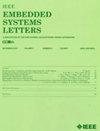XOR-Free Approach for Implementation of Polar Encoder
IF 2
4区 计算机科学
Q3 COMPUTER SCIENCE, HARDWARE & ARCHITECTURE
引用次数: 0
Abstract
This letter presents a new algorithmic approach to construct an XOR-Free architecture for a nonsystematic polar encoder (NSPE). Optimization of XOR units is the main concern while implementing NSPE, which consumes a significant amount of dynamic power. To generate polar sequences of code length N, the approach uses无xor的极坐标编码器实现方法
本文提出了一种新的算法方法来构建非系统极性编码器(NSPE)的无xor结构。在实现NSPE时,XOR单元的优化是主要关注的问题,它消耗了大量的动态功率。为了生成编码长度为N的极序列,该方法使用从$(N/2)^{\mathrm { th}}$阶生成器矩阵$G_{N/2}$而不是$G_{N}$中提取的$(N/2)-1$二进制模式。该算法利用递归模式减少了逻辑运算,从而提高了硬件成本。模式逻辑是用2:1多路复用器和逆变器推断出来的,使实现无xor。针对可变代码长度编写了一个自动HDL代码生成脚本($2{^{{3}}} \leq {N} \leq 2{^{{10}}}$),以便与类似的方法进行直接比较,即阶段折叠和穿孔NSPE设计。结果表明,所提出的结构将面积提高了31%%–83% and power consumption by 15%–57% for various N and code rates ( $R{=}1$ , 1/2) on Virtex-6 FPGA devices.
本文章由计算机程序翻译,如有差异,请以英文原文为准。
求助全文
约1分钟内获得全文
求助全文
来源期刊

IEEE Embedded Systems Letters
Engineering-Control and Systems Engineering
CiteScore
3.30
自引率
0.00%
发文量
65
期刊介绍:
The IEEE Embedded Systems Letters (ESL), provides a forum for rapid dissemination of latest technical advances in embedded systems and related areas in embedded software. The emphasis is on models, methods, and tools that ensure secure, correct, efficient and robust design of embedded systems and their applications.
 求助内容:
求助内容: 应助结果提醒方式:
应助结果提醒方式:


